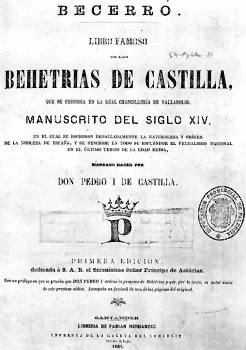Nine Valleys lawsuit
[7] During the Late Middle Ages the territory that today is Cantabria was divided into merindades, fiscal and legal administrative divisions of the kingdom of Castile controlled by a merino.
[3] The Asturias de Santillana valleys, before the power of the first Duke of Infantado spread through them, were free to hold general assemblies.
[11] The Vega family received in 1341, from the hand of Alfonso XI, the valleys of Carriedo, Villaescusa, Cayón, Camargo and Cabezón, along with other properties.
[11] It must be said that at the beginning of the 16th century, in the territories controlled by the Duke of Infantado, and especially the Asturias de Santillana, the peasantry suffered a continuous increase in taxes, which stirred up discontent.
This situation occurred in Trasmiera, the valleys of Soba and Ruesga, and in that of Carriedo since the Duke of Infantado lost power after the sentence of 1505.
However, Íñigo entered the valleys with great violence, taking possession of them by force of arms, which provoked the anger and rebellion of the peasants.
Because the Prince, my very dear and beloved son, ceded and transferred to you Yñigo Lopez de Mendoça my vassal, and of my council, all and any right and demand and appeal, that in any way to my belonging and belonging could, in the valleys and districts, and terms of certain valleys of Asturias de Santillana, and in each one of them on which is this dispute and debate, contention and controversy, between me and my procurator, and Fiscal procurators of the one part and the Procurator or Procurators of the said Yñigo Lopez of the other part, in the which lawsuit they were received in evidence, and date determined by the parts, likewise the property as well, as to that of the ownership of the said places and valleys, and terminos, and districts, and of all the aforementioned, and of the civil and criminal, high and low jurisdiction, mero et mixto imperio, and of all the rents and facts and rights, and of the things pertaining to the manorialism of all the aforementioned (...) as it is said, in you and your successors, universal and singular, and in whoever you want and for good you want, without annoyance or disturbance, or any disturbance, from me or my successors.This marquisate included the valleys of Carriedo—later split after its lawsuit—, Cayón, Penagos, Villaescusa, Piélagos, Camargo, Reocín, Cabezón, Cabuérniga, Alfoz de Lloredo—all of them split after the Nine Valleys lawsuit—, Anieva, Cieza and Lamasón, as well as the town of Santillana, the domains grouped under the name Tierra de la Vega (English: "Land of de La Vega"), and Pando (now Torrelavega).
[20] Carriedo, located southeast of the Asturias de Santillana, then belonged to the Velasco family and was coveted by the Mendozas; the peasants were reluctant to fall in front of the lords, who used violence to make them desist from their efforts.
[3] In the Carriedo lawsuit, the valley declared that it had not denounced its lordly situation during the reigns of John II and Enrique IV of Castile "because there was always favour and wars and fears".
The said duke by force and not duly, has entered and occupied against all reason and justice the said valleys...[15]The first sentence (in degree of view[23]), of 17 October 1553,[14] was positive for the valleys, who achieved advances in matters of taxes and rents for the dukes, as well as considering the civil and criminal jurisdiction of their territory as royal right, returning it to the royal manor.
The prosecutor Juan García even considered perjury more than fifty witnesses who testified in favor of the duke,[24][25] who filed as many as four allegations.
[22] The Nine Valleys wanted to join the Carriedo lawsuit as a precedent and concentrated their arguments on the following points:[14] The royalty was happy to regain power in the north of the Iberian Peninsula, successively lost for three centuries.
There are several testimonies about the atrocities committed by order of Íñigo López de Mendoza, his friends and followers before and during the years that the lawsuits lasted.
Juan Martínez, witness in the lawsuit, assured that the duke had entered his valley surrounded by men with banners, atabals and trumpets and had made it surrender by force, making people and cattle flee to the mountains.
[14] Don Íñigo even mistreated hidalgo opponents related to the house de La Vega, and imprisoned one of them for eight months.
[15] When the Infantado finally lost the lawsuit of 1581, the contemporary duke decided to focus his attention on the last territories that were granted to him in other parts of the peninsula.
(English: "Memorial presented to the King by the Duke of Infantado in the lawsuit against the Prosecutor and the 7 valleys of Villaescusa, Cayón, Penagos, Camargo, Cabezón, Alfoz de Lloredo and Piélagos").
[35] The following table shows the contribution of Fernando José de Velasco y Ceballos, who associated some of the towers cited to possible lineages.


